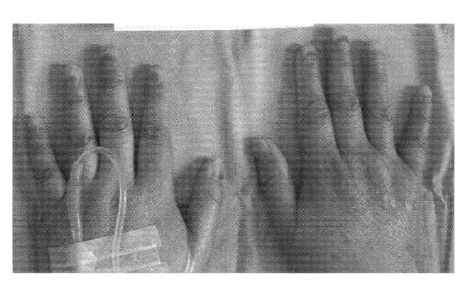INTRODUCTION
The cutaneous toxicities following chemotherapy include erythema, desquamation, hyperpigmentation and onychopathy, such as koilonychia, pitting and onycholysis. Anthracyclines alone, or in combination with mitomycin, bleomycin and taxanes, are reported to cause onycholysis, a process in which a nail is separated from its bed1). Such nail toxicity may result in loss of the nail, sometimes leading to serious infection during the period of neutropenia following systemic chemotherapy. A study has suggested the incidence of nail toxicity associated with taxoids can vary between 0-and 44%2). However, Zero toxicity may reflect the effects were either unrecorded or underestimated. Despite nail toxicity being a quality of life factor for cancer patients receiving taxane chemotherapy, there is no consensus regarding nail toxicity severity criteria, or guidelines for appropriate management. Here, a case of nail toxicity that arose following docetaxel treatment every 3 weeks is reported.
CASE REPORT
A 55-year-old woman presented with advanced gastric cancer with multiple lymphadenopathy, including a 4×4 cm-sized left supraclavicular lymph node and an intra-abdominal lymph node. There was no history of previous chemotherapy treatment. Treatment involved the administration of an oral fluoropyrimidine, xeloda, at a dose of 2000 mg/m2/day for 14 days, and docetaxel at a dose of 75 mg/m2 once every 3 weeks, from day 1. A partial response was observed after two courses of chemotherapy. The patient complained of nail pigmentation on the proximal one third of the nail plates (Beau’s line) of all 10 fingers after three cycles of chemotherapy. Inflammation of the fingertip skin was also noted (Figure 1). The electromyography data were normal. The patient experienced febrile grade IV neutropenia twice during the five courses of chemotherapy. A total of six cycles of combination chemotherapy were administered.
DISCUSSION
Onychopathy is often associated with systemic chemotherapy. The severity of the onychopathy may depend on the duration and cumulative dose of the chemotherapeutic agents, as well as on the nail constituent involved3, 4). Abnormalities of the nail plate, as a result of systemic chemotherapy, can involve matrix damage (typically at Beau’s lines), onychomadesis, due to arrest of epithelial proliferation, and leukonychia, due to abnormal keratinization.
The common toxicity criteria of the National Cancer Institute (version 2.0) describe two types of nail change: grade 1-discoloration, ridging or pitting; and grade 2-partial or complete loss of nail(s), or pain in nail beds. However, Spazzapan et al. suggested three grades of nail toxicity: grade 1-discoloration, ridging or pitting; grade 2-partial loss of nail(s) or pain in nail beds not interfering with function; and grade 3-partial loss of nail or pain in nail beds interfering with function, or complete loss of nail(s)5).
Chemotherapeutic agents appear to stimulate normally quiescent nail matrix melanocytes, resulting in nail plate pigmentation and reduced nail growth. Since exposure to sunlight can aggravate nail toxicity, the use of gloves or artificial nails is advised for patients receiving taxanes or anthracyclines for prolonged periods1). The absence of sebaceous glands, horny cells and a stratum granulosum, and a relative deficiency in stage IV melanosomes, may make the hyponychium vulnerable to UV radiation6). Clinicians should be particularly aware that infection, possibly leading to sepsis, may result from nail toxicity during the period of neutropenia caused by chemotherapy.
Taxoid is a chemotherapeutic agent used in the treatment of breast, ovarian, lung and bladder cancers. Paclitaxel and docetaxel are administered every week or every three weeks. Weekly administration of taxanes is reported to lessen acute toxicity and enhance the effect of the drug7). The common side-effects of taxane are myelosuppression, neurotoxicity, alopecia, hypersensitivity reaction and myalgias. Recently, nail toxicity associated with taxanes, paclitaxel and docetaxel has been described, which manifests in a variety of clinical pathologies, such as onycholysis, splinter hemorrhage, subungual hematoma, subungual abscess and paresthesia. The incidence of nail toxicity associated with taxanes ranges up to 44% of patients, although some studies do not mention any adverse nail events3). In terms of neurotropic affects, it has been suggested that taxoid-related nail changes are associated with an altered integrity of the peripheral nerves, and that this is linked to neuropeptide and prostaglandin release by nociceptive C-fibers and sympathetic postganglionic terminals, respectively, which may cause neurogenic inflammation8, 9). These studies also noted that cyclooxygenase-2 inhibitors improved the condition of nails.
In the present study, the patient’s onychopathy improved after reducing the initial dose of docetaxel to 75%. Nail toxicity is likely to impact on the quality of life of cancer patients. Different managements are required according to the grade of chemotherapy-induced onychopathy. More careful examination of nails is also required during evaluation of systemic chemotherapy toxicity, and nail events should be documented in phase II studies that use taxane chemotherapy.




 PDF Links
PDF Links PubReader
PubReader ePub Link
ePub Link Full text via DOI
Full text via DOI Download Citation
Download Citation Print
Print





